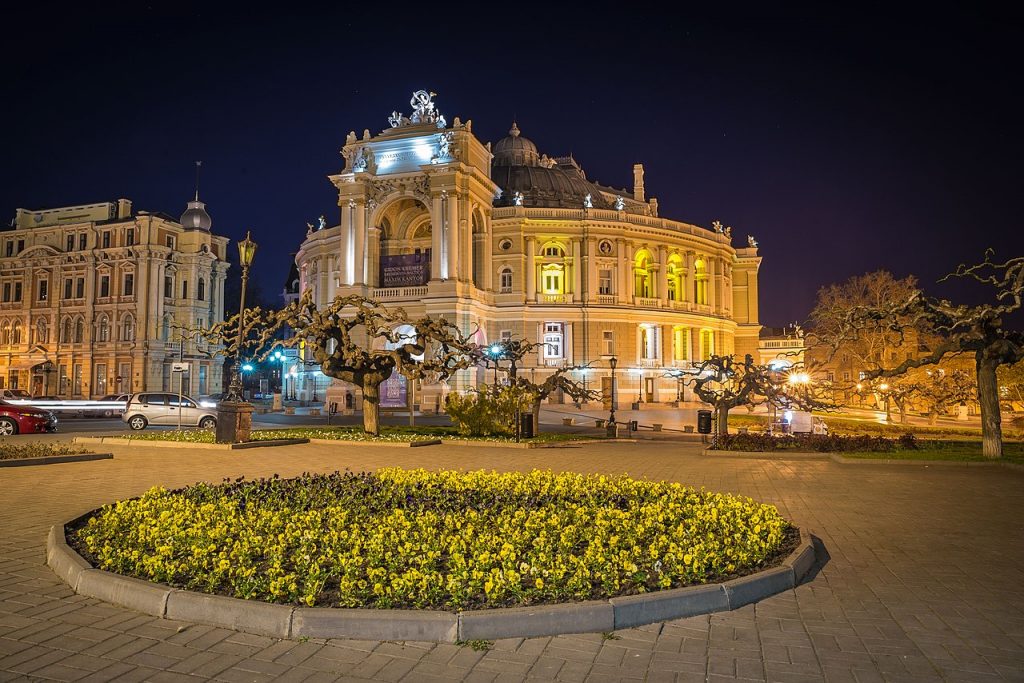
The terrifying war against Ukraine changes, of course, the function of these pages devoted to the Jewish cultural heritage of that country. Many of the places mentioned were razed to the ground by bombs. While these pages are not intended in the present time for tourism, they may be useful to researchers and students as historical references. References to so many painful histories during the pogroms and the Shoah, but also to the glorious history of Ukrainian Judaism, in its cultural, religious and Zionist dimensions. Wishing the Ukrainian people a speedy end to these atrocities of which they are victims.
Established in 1794, Odessa was captured by Admiral de Ribas from the Turks for Empress Catherine II of Russia. The city developed rapidly during the nineteenth century, largely due to the arrival of colonists from “New Russia”. It soon became a melting pot of Russians, French, Armenians, Poles, Greeks, Moldavians, and Jews. Forbidden to reside in Saint Petersburg, Moscow or Kiev, Jews poured into the southern Russian cities of Odessa and Nikolayev, eventually constituting a third of their population before the Second World War. Even today, Odessa still bears their mark.
A Jewish city
An Odessan was asked one day,
-How many people live in Odessa?
-One million.
-And how many of them are Jews?
-I just told you. One million.
You see, in people’s minds, “Odessan” and “Jews” are often confused.
Jewish Odessa began at the Greek Square (“Gretsk, that’s what they call the street where the Jews do business”, Sholem Aleichem wrote), Alexandrovski Prospect, the old marketplace, and the streets named Evreiskya, Bazamaya, and Malaya-Arnautskaya. It continued on the other side of Preobrajenska Street, down Tiraspolskaya to Staroportofrankovskaya streets, and beyond that to the neighborhood by the train station. It covered the entire Moldavanka suburb, where the famous Privoz market is found, and ended at the Slobodka district, where the deportation convoys waited during the German-Romanian occupation. The Jewish quarter encompassed a tremendous area, in other words, stretching from downtown all the way to the western and northern suburbs. Before the war, 350,000 Jews lived here. They number no more than 50,000 today.
Touring Jewish Odessa involves a great deal of footwork. You need to pace up and down the streets, stroll through the neighborhoods, enters and exit courtyards… At Privoz market , breathe in the smell of fresh vegetables, bitter herbs, almonds and raisins, and soak up the atmosphere of the Moldavanka, the children playing in the streets. As fancy suits you, stop by one or more of the few remaining synagogues, examine the various monuments and plaques, and pay a visit to the Slobodka cemetery.
Odessa, the birthplace of Klezmer music
Odessa was also the birthplace of Klezmer music. Blending clarinet, cello, and balalaika with Middle Eastern rhythms, klezmer is making a comeback in Europe after crossing the Atlantic. In Odessa, the klezmer group Migdalor improvises from scores by Alexander Tcherner.
The synagogues of Odessa
Before the First World War, Odessa contained seven synagogues and forty-nine prayer houses. The oldest was the Brodskaya (Brody), or Choral, SYnagogue, built in 1840. With its four domes, it still towers over the intersection of Pushkin and Jukovysky streets, and archival warehouse today. The beautiful building has been given back to the Jewish community of the city and will be transformed back into a synagogue within a few years.
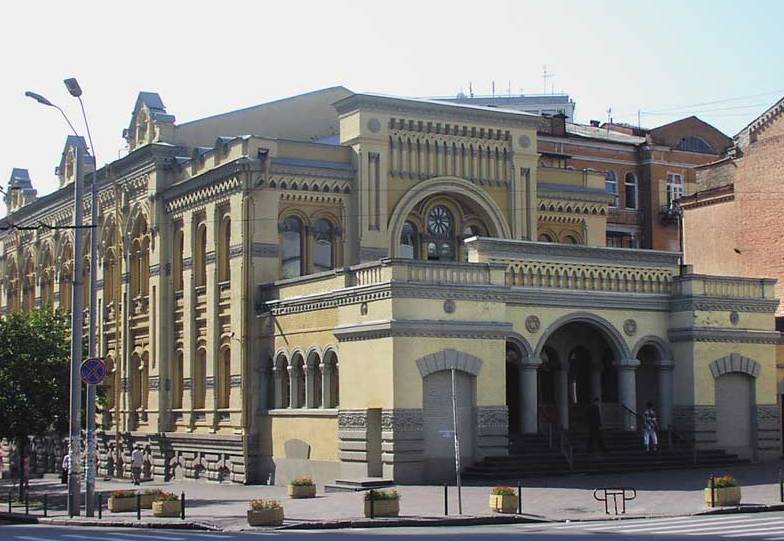
Only two synagogues are still in service: the Glavnaya (Main) Synagogue and the Hasidic Synagogue. There was also a Dockworkers’ Synagogue (near the port, now in ruins) and even a synagogue for kosher poultry shellers.
The Glavnaya Synagogue was returned to the Jewish community a few years ago after being converted into a gymnasium. Until recently, the markings of a basketball court could still be seen on the floor. The women’s galleries have ben removed, while a wall has been built on the first floor that divides the main room into two sections. The fairly new community manages a school and dormitory and publishes Or Sameakh, a daily newspaper. On holidays like Purim or Passover, the synagogue reverberates with the hubbub of the faithful.
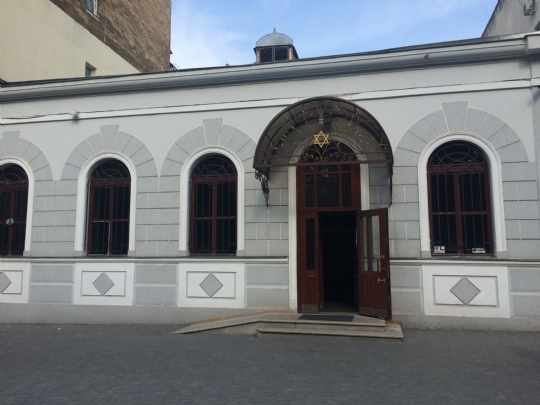
The smaller Hasidic Synagogue , which has a beautiful interior, was recently removed. Located on Malaya-Arnautskaya Street, the Jewish Cultural Center offers Hebrew instruction and organizes various events. At number 9 of this street lived the writers Hayyim Nahman Bialik and Ilya Ilf (from his real name Fainzylberg). Ilf was born in Odessa right near the train station, where a plaque in his memory has been mounted.
In the footsteps of Isaac Babel
The most famous character set in Jewish Odessa was the bandit Benia Krik, gangster king and hero from Isaac Babel’s Odessa Tales. The writer painted a portrait of the Jewish life of the suburb of Moldavanka: “[…] Our generous mother, a life filled with suckling children, rags out to dry and wedding nights full of suburban chic and the indefatigable vigor of a trooper”.
Isaac Babel
Isaac Babel (1894-1941), born in Odessa in the Moldavanka suburb and author of the Odessa Tales, admired Flaubert and Maupassant and made an impression of Gorki. He joined Semion Budenny’s Red Cavalry during the civil war and, though in favor of the Revolution, was nevertheless arrested in 1939 and executed in 1941. His work, now among classic of twentieth-century fiction, was rediscovered in the 1950s.
Getting your bearings in Odessa os rather difficult, for no map yet exists showing the new street names, while the residents only know the old ones. To find the places depicted by Isaac Babel in Moldavanka, who lived at 23 Dalnitskaya Street, arm yourself with a map, get a sense of the street layout, and compare what you see to Babel’s descriptions.
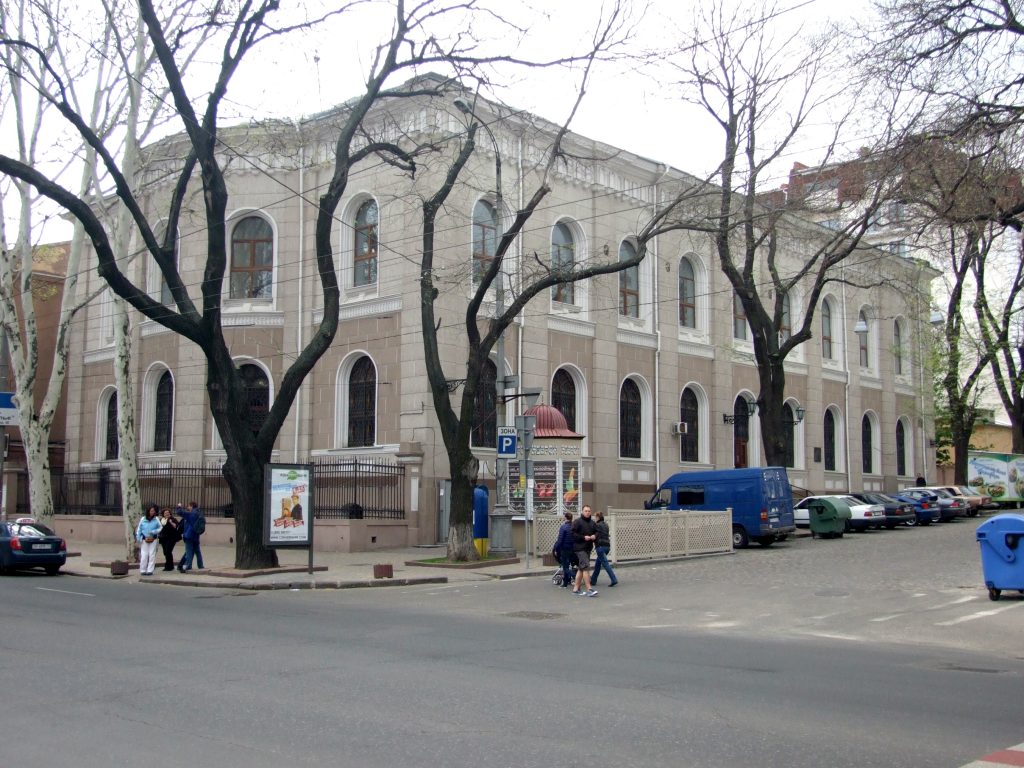
The shop owned by Liubka Shneeweiss, or Liubka the Cossack, was located at the intersection of Dalnitskaya and Bankoskaya streets, near the present-day Isaac Babel Street (formerly Vinogradnaya). Gluchaya Street, where the gangster took refuge in Yoska Samuelson’s house of tolerance, today bears the name Bougaevskaya, after many years as Instrumentalnaya. Prokhorovskaya Street, where Piatirubel the blacksmith lived, after years as Chvorostin has taken back its previous name.
At the triangular public square formed by Prokhorovskaya’s intersection with Staroportofrankovskaya (Old Free Port) Street, a monument was recently erected commemorating the deportation of ghetto residents to Bogdanovka, Domanievka, Beriozovka, and other Trans-Dniestrian extermination camps between 1941 and 1943. Tens of thousands of Odessa’s Jews died in the camps.
Promenade with Sholem Aleichem and Eisenstein
Not far from the square, a picturesque street bore the name of Sholem Aleichem during the Soviet era; it now bears its previous name, Miasoedovskaya (meat eaters). The Jewish Hospital was found at this street’s intersection with Bogdan-Khmelnitsky Street.
Odessa, whose famous steps were immortalized by Eisenstein in Battleship Potemkin, was also home of the writers Ilf and Petrov (authors of the very funny Twelve Chairs), Arkady Lvov, Sholem Aleichem; the musicians Jascha Heifetz, Emile Gilels; and other famous figures.
The cemeteries
The first Jewish cemetery in Odessa (the oldest grave dates to 1793) was razed and turned into Illitch Park, just behind Privoz. Only the layout of the paths here hints at the former purpose of this place.
The second Jewish cemetery, near a retirement home, was located on Lustdorfskaya Street, in front of the Orthodox cemetery. Only the entrance arcade remains. The grave of the Yiddish writer Mendele Mokher Sefarim was supposedly moved into another cemetery.
The only Jewish cemetery left to visit os found at the very end of the long Razumovskaya Street, at the intersection of Khimicheskaya Street and Leningradskoya Road. It is very large, well kept, and constantly visited; it does not have that neglectful aspect common to most Jewish cemeteries in Ukraine.
The Jewish Museum of Odessa
To finish your visit of the Jewish Odessa, you can visit the Jewish Museum. Although it is a modest institution, you will nevertheless find original documents about the Jewish past of the city. Its very helpful staff will be glad to inform you about the Jewish events in the city during your stay. In addition, you should visit the Website of The Odessa Review, edited by Regina Maryanovska-Davidzon and Vladislav Davidzon, to keep up to date with the cultural events happening in Odessa.
Odessa, between yesterday and today
Today, only 3% of Odessa’s population is Jewish, approximately 30000 people. However, the city is still seen as one of Europe’s Jewish capitals. When, in 1916, Isaac Babel, wrote about a “city built by Jews”, he didn’t only refer to the number of Jews, but also to the general atmosphere, tolerant toward minorities.
Recently, archaeologists unveiled Jewish tombs dating from 1770, thus proving that a Jewish community existed there before Odessa’s creation. Indeed, in the 18th century, Jews were salt dealers in this province, that was then known under the name Hadjibey. According to the records, before its conquest by Iossif Derbos, about 10 Jews lived in this region. A hundred year later, there were 138000. The first Jewish inhabitants of Odessa came from the Russian Empire’s shtetls, and from the well-known city of Brody in Galicia. A lots of Jews bore the name of the shtetl they originated from.
The first Jewish inhabitants of Odessa were attracted by the privileges offered by the Russian Empire to the volunteers willing to settle in South Russia. For the Jewish community, it meant escaping the oppression they suffered from in the rest of the Empire. In Odessa, Jews were almost equal to other citizens. Therefore, 100 years after its creation, one third of Odessa’s population was Jewish, and became known as “the star of exile”, as Babel described the zionist movement in the city. Let’s add that leaving the shtetl for Odessa meant -in general- an increased quality of life. For some, the possibility of emigrating to Palestine, from a dream, became a reality. The frequent pogroms also fostered the rise of zionism in Odessa. Still, in 1941, half of the population was Jewish.
Life in the different quarters of the city
To the difference of many cities in the Russian Empire, Odessa didn’t have a Jewish quarter. Although some locations such as Moldavanka, Yevreyskaya, Bazarnaya, and Malaya Arnautskaya were at the center of the everyday community life. Being from small communities, the Jewish population tended to reproduce in Odessa the structural system they knew in the shtetl. Everyday life evolved around the synagogue, the mikveh, the school, the kosher butchery and charitable organizations. The first community newspaper was published in 1795.
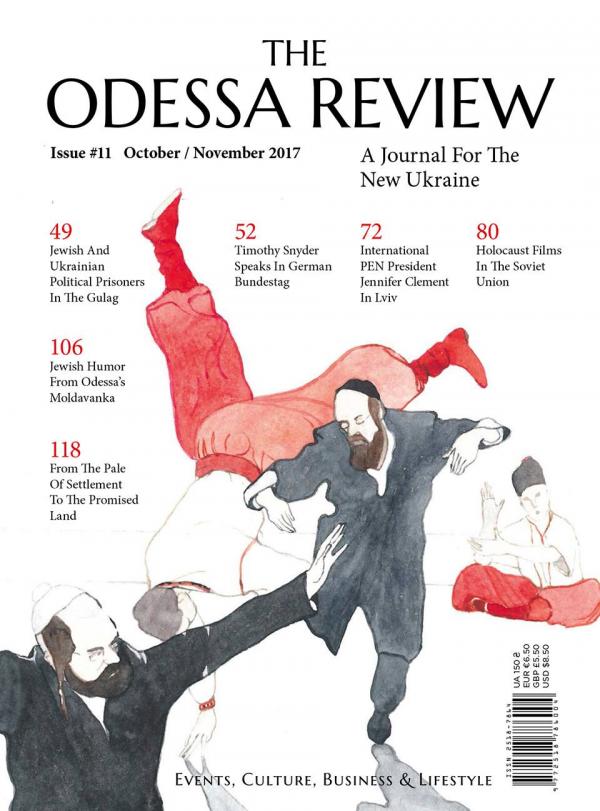
The community elite was personified by Brodsky’s Jews, seen as the most educated, wealthy and liberals. In general, the European aspiration of the Brodsky Jews, the fact that Odessa was geographically far away from the centers of Judaism, the diversity if nationalities and social classes composing the city: all those elements explain why Odessa’s community was unique.
At the beginning of the 20th century, Odessa became the biggest market for exchanges and buisinesses in South Russia. Jews managed 90% of the seed export business ; owned 50% of the factories ; produced the white stones that served to the city’s construction ; the Korelsky family managed the biggest tobacco factory of the Empire etc…On the other side, one third of the city’s Jews lived in poverty.
Visiting Odessa through its old synagogues
In addition to the two synagogues already mentioned, here is a list of buildings that once were homes to prayer houses.
Bakers’ Synagogue , established in 1875. Today a school.
Yavne Synagogue , prayer house of Bialik and the zionist movement. Today a private house.
Butchers’ Synagogue , closed in 1925. The building was given back to the city’s Jewish community in 1991.
Furnitures’ makers Synagogue , today a children pre-school.
The Nakhlas Eliezer’s Synagogue, located 5 Lesnaya, was destroyed by an inundation in 1990. It is today in ruins.
Those three buildings hosted prayer houses as well : 10 Nechipurenko, 7 Bolgarskaya and 48 Kuznechnaya.
Odessa’s charitable organizations
Odessa was known by every European Jew as a city with numerous charitable organizations. The oldest one was the Jewish hospital, opened in 1802. A century later, the city hosted a dozen Jewish organizations.
Jewish merchants organization
Modalvanka Jews charitable organization
Charitable organization for Odessa poors
Charitable organization for Jewish students
Jewish soup kitchen
Education
In 1828, the first Jewish high school of the Russian Empire opened in Odessa. In addition to the Yeshiva’s learning, students were also taught “secular” subjects. The Jewish arts and crafts college inaugurated in 1864 contributed to the reinforcement of the community in the technical and mechanical field. Moreover, at the Tarbut school, class was made in Hebrew by teachers such as Chaim Nahum Bialik or Shaul Tchernikovsky.
The “Gate to Zion”
Historian Steven Zipperstein notes that the history of Odessa’s Jewish community is closer to the one of San Francisco than the one of Kiev. In this port city, the Jews lived without the constraints and limitations of the Russian Empire. They were not isolated and were an active part of the city’s life. The language barrier didn’t apply as well. However, at the end of the 19th and beginning of the 20th century, the tolerant and multicultural Odessa was nicknamed “Gate to Zion”. Indeed, it became one of the centers of the zionist movement, and the city where thousands of Jews left to Palestine.
The center of the zionist activity was the “Palestine Committee”. This organization helped the relocation of farm workers and craftsmen in Palestine. The committee was initiated in the 1880s by Lev Pinsker, Ahad Haam, Bialik, Klauzner, or Ben Ami were also part of the board. The members also raised funds to buy lands in Palestine. The land were the Hebraic University of Jerusalem was built was purchased by the committee. This is why Lev Pinsker was displaced there in 1934.
One of the most active members of this committee, Meir Dizengoff, was the first mayor of Tel Aviv. This is merely a coincidence. In some respect, Tel Aviv was built in Odessa. Lilienblum, one the yishuv first journalist, wrote that in Odessa, Jews arrived to the shores of the black sea, built a city and developed a port. If they were able to to that in Odessa, they would achieve their goal on the shores of the Mediterranean as well.
Another center of the zionist activity was the Brodsky synagogue. Around 70 houses were built through fund raising executed by the synagogue. Those buildings were the first of the future city of Nes Ziona.
To properly prepare the future emigrants, an Hebrew-only school was opened in 1903. In the same time, the publishing house Moria published school books in Hebrew and sends them to Tel Aviv.
From 1919 to 1927, the boat Ruslan shipped a numerous part of the Odessa intelligentsia to Palestine. Among them, lots were about to become the leaders of the future Israel.
On the footsteps of Odessa’s illustrious Jews
Ahad Ha’am (1856-1927), philosopher and publicist, lived in Odessa from 1887 to 1907, at two addresses: 11 Sturdzovsky and 26 Bolshaya Arnautskaya (the latter was destroyed in 2006).
Isaac Babel (1894-1940), writer, was born in Odessa and lived there until 1911, then in 1919 and 1920. He lived at 17 Rishelievskaya (commemorative plaque), 23 Dalnitskaya (the house is destroyed), and 12 Tiraspolskaya.
Eduard Bagritsky (Dzubin) (1895-1934), poet, was born in Odessa and lived there until 1925, at 40 Bazarnaya (commemorative plaque), 4 Osipov, 21 Konnaya, 40 Koblevskaya, 3 Novobazarny and 13 Belinsky.
Chaim Nahman Bialik (1873-1934), poet and educator, lived in Odessa between 1892 and 1921 at 6 Vagnerovsky and 9 Malaya Arnautskaya.
Meir Dizengoff (1861-1936), first mayor of Tel Aviv, lived in Odessa from 1895 to 1905 at 30 Osipov.
Simon Dubnov (1860-1941), historian and educator, lived in Odessa from 1890 to 1902 at 12 Bazarnaya.
Vladimir (Zeev) Jabotinsky (1880-1940), writer, poet, publicist, Zionist leader, was born in Odessa and lived there until 1898, then between 1901 and 1903, at 33 Bazarnaya, 1 Yevreyskaya (commemorative plaque), and 91 Novoselsky.
Ilya Ilf (Fainzilberg) (1897-1937), writer and satirist, was born in Odessa and lived there until 1923, at 137 Staroportofrankovskaya (commemorative plaque), 9 Malaya Arnautskaya, and 19 Sophievskaya.
Joseph Klauzner (1874-1958), historian, publicist, Zionist leader, chief redactor of « Ha-Shiloah » review, lived in Odessa between 1890 and 1919.
Mendele Mocher Sforim (S.Y. Abramovitch) (1836-1917), writer, lived in Odessa between 1881 and 1917 at 12 Degtyarnaya.
Leon Pinsker (1821-1891), doctor, educator, founder of the « Palestine Committee », lived at 26 Rishelievskaya. The original building was destroyed but a commemorative plaque is apposed on the new building.
Avraham Menahem Mendl Usyshkin (1863-1941), Zionist leader and administrator of the « Palestine Committee » lived at 46 Pastera.
Schalom Aleikhem (S.N. Rabinovitch) (1859-1916), writer, lived in Odessa between 1891 and 1893 at 26 Kanatnaya.
Interview of Isabelle Némirovski, Professor at INALCO (Jewish and Hebrew studies), founder and president of « The Friends of Odessa » association, following the publishing (Editions Honoré Champion, April 29th, 2022) of her book History, Memories and Representations of the Jews of Odessa.
Jguideeurope: Your book proposes to share the 1001 stories of these characters who populated and enriched the fabulous History of Odessa. What motivated you to write this book?
Isabelle Némirovski : You are right, my book welcomes a multitude of small stories that have germinated and grown on the fertile soil of Odessa throughout its great history. I wanted to draw the Odessa landscape in small coloured touches of tales and realities. An often perilous writing exercise, knowing that this work is originally a doctoral thesis. But not to play the balancing act would have led me to describe a city with vanished charms. The marriage of these two elements was necessary for its understanding. The dream also invited itself in the Odessite representation, and this, from the title of my book: “An old intimate dream”. The first words quoted in the exergue then confirmed this desire for a dreamlike journey: “To my grandfather Shlomo Nemirovski, whom I never knew. He led me to the shade of the acacia trees in Odessa, immersed in my reveries…”. However, beyond this desire to “return” to the land of my Odessite Jewish ancestors through dreams, a more “down-to-earth” observation is at the origin of this desire to write: Odessa has no book of remembrance whereas many Jewish towns in Central and Eastern Europe have a yizker-bukh. Yet three quarters of the Jewish community was decimated during the Second World War by the Nazis and their Romanian allies. Moreover, Odessa the Jew has greatly contributed to the world’s cultural heritage. This book therefore proposes to “repair” this oversight in part by writing the history and the little story of this society before the genocide, by establishing the chronology of the massacres, by simply fulfilling a duty of truth. For how else can we pass on the truth?
Which reality and which important character do you think are not well known?
It’s the history of Odessa and its Jewish community that remain, in my opinion, too little known. Who knew how to locate Odessa on a map before the Russian invasion of Ukraine? The family story passed on by my father to his children never associated Odessa with a Russian city but with the homeland of music with its great violinists. Dissatisfied with this reductive approach to the place, I decided to propose a reading that would take into account the complexity of the Odessa “concept” with its multiple components – historical, social, political, economic but also emotional – which have come together and mutually fertilised over time. My “Tales of Odessa” invite the reader to leave the idyllic framework of the city that has been immortalized by the cameras of experts in souvenir shots. I decided to peel off the flattering labels and break through the barrier of faded evidence about the city of Odessa to explore its deeper nature and to act as a revealer of its “invisibility”, a potential source of genius of place. I also thought of my missing ones, those missing from Odessa’s Jewish history… I went to meet them… An index of names at the end of the book lifts the veil on these forgotten people, bankers, merchants, intellectuals, artists, bandits and “ordinary Jews” who have similarly written the modernism and the colourful legends of Odessa the Jew.
Is the sharing of Odessa’s Jewish cultural heritage all the more important in the face of the risk of destruction of places due to the current war in Ukraine?
The world unfolds priceless riches within sight, but it takes tragic events for the individual to become aware of them and begin to appreciate them. For the time being, Odessa is spared from the war. But Odessites are preparing for the worst and are multiplying acts of resistance. A photograph is circulating on social networks: the statue of the Duke of Richelieu covered with sandbags. Another more sonorous one shows singers in front of “their Opera House”, imploring the sky in music to protect the city from the curse. As the heir to this fabulous culture, I have only one desire: to share it. I hope that this bloody conflict will be an opportunity to shine the spotlight on a place, a heritage, and men and women who have been forgotten for too long.